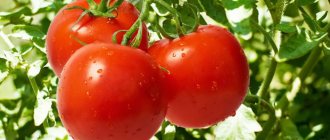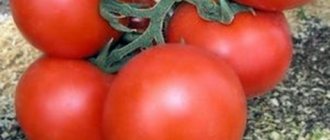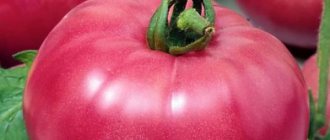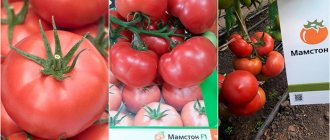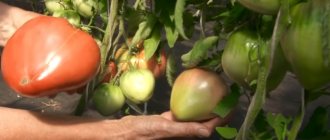Vegetable growing » Tomatoes
0
1526
Article rating
Kira Stoletova
Tomato Goose Egg (can also be found in the name of the Siberian Garden series) is an excellent large-fruited variety for universal use. One of the leaders in the seed market among its type. Well suited for recycling, but also ripe fruit will satisfy the refined taste of the taster. In the garden, the bush looks beautiful: rich green leaves, an interestingly shaped fleshy sweet tomato, excellent height of the bush, elegant clusters. Any gardener who only speaks positively about the variety will be pleased with its good yield.
Characteristics of tomato variety Goose Egg
Description of tomato variety Goose egg with photo
This species is classified as indeterminate, which means that the growth of its shoots is unlimited in the presence of favorable conditions. You can grow the Goose Egg tomato in greenhouses and open ground. The height of the bushes in the first case reaches 2 m, and in the second - 1.7-1.8 m.
The plant is densely leafy and spreading, so throughout the season it is necessary to form a bush and remove stepsons. Also, when growing the species, it is necessary to use supports.
Important! Bushes of this variety show maximum performance when forming 1-2 shoots.
The leaf blades of the species are of standard size and dark green in color. The inflorescences are simple. The first fruit cluster grows above the 7-8th leaf, and subsequently every three. Each of them contains 4-8 fruits, which ensures good yield. It is noteworthy that at the bottom of the bush there are more tomatoes, but they are smaller in size than at the top.
When five fruit clusters are formed, the main shoot must be pinched so that all the tomatoes have time to ripen before frost arrives. The bushes begin to bear fruit at 110-115 days. The ripening of the crop occurs gradually.
Important! Goose egg tomato seeds can be used for sowing, as this species is a cultivar.
Description of fruits
Tomatoes Goose egg, as shown in the photo, is oval-round in shape. Some specimens have ribbing near the stalk. The average weight of tomatoes is 200-300 g, and some weigh up to 350 g. The color of the fruit when ripe changes from dark pink to rich red.
The pulp is fleshy, elastic, strong. When cutting tomatoes, no liquid comes out. The taste of the fruit is sweetish with a slight hint of acid. Goose egg tomatoes have a rich tomato aroma.
The skin is thin and dense, but when the fruit ripens it can be easily separated from the pulp. Tomato Goose egg is not damaged during transportation and long-term storage. When harvested at the stage of technical maturity, tomatoes retain commercial quality and taste for 45 days.
The ripening of tomatoes on the fruit cluster occurs almost simultaneously. In this case, it is necessary to immediately collect them, since they can crumble under their own weight.
Important! Goose egg tomatoes contain a small amount of seeds, so this must be taken into account when collecting planting material.
Characteristics of tomatoes
Tomatoes of this variety have the following characteristics:
- The shape of the tomatoes is well reflected in the name of the variety - they actually somewhat resemble a large egg. But the shape can vary somewhat depending on growing conditions, and the surface of the skin can be either completely smooth or with significant folds at the base of the stalk.
- The fruits are initially green in color with a pronounced dark spot at the stalk. When ripe they turn orange-red. The stain disappears completely.
- Manufacturers characterize these tomatoes as having high pulp density, but consumer opinions differ on this point. Some agree with this assessment, while others believe that the flesh cannot be called dense, especially when fully ripe.
- The skin of tomatoes is very thin and can be easily removed from the fruit.
- Tomatoes could be called cream, but they are much larger in size than regular cream. On average, the weight of the fruit is about 200 grams, but in the upper clusters the weight of many fruits reaches 300 grams. Therefore, the Goose Egg variety is often classified even as a large-fruited tomato.
- Taste characteristics can be called good and excellent. Despite the fact that the manufacturer calls this variety of tomatoes one of the best for pickling, they are also quite good for fresh consumption in salads.
- Due to its dense consistency and significant amount of dry matter, the fruits of this variety are suitable for drying, drying and freezing.
- The safety and transportation of fruits is very high. Can be stored in cool conditions for up to 45 days.
- Tomatoes ripen very well when picked green. Although, according to some reviews from gardeners, fully ripe tomatoes of this variety do not last as long as we would like.
Characteristics of tomato Goose egg
When choosing such a variety, you should study its main characteristics. This information will allow each gardener to learn in more detail the characteristics of the species and achieve maximum efficiency.
Tomato yield Goose egg and fruiting
Goose egg is a mid-early variety. The first harvest of fruits can be carried out in the last days of July or early August. Productivity per 1 sq. m in open ground is 7-9 kg. To increase it, it is necessary to timely fertilize and water the bushes. Since any lack of nutrition can negatively affect the quality and quantity of tomatoes.
The harvest in open ground is better than in a greenhouse
The harvest in open ground is better than in a greenhouse
Area of application of fruits
Tomato Goose Egg is universal in use. Tomatoes can be eaten fresh or processed. But due to the large size of the fruit, this species is not suitable for whole-fruit pickling or canning in jars.
Goose egg is best used for cooking:
- juice;
- pastes;
- sauce;
- lecho;
- salads;
- assorted vegetables.
Important! During heat treatment, the pulp retains its structure, but changes its taste slightly.
Resistance to diseases and pests
Goose eggs, like many other types of Siberian selection, have high natural immunity to common diseases, such as:
- late blight;
- crown rot;
- various types of spotting;
- mosaic.
Also, this species easily tolerates short-term drought, cool conditions and temperature changes.
When growing tomatoes in a greenhouse, it is possible to suffer from whitefly, and in open ground – from the Colorado potato beetle at the initial stage of seedling growth.
Diseases and pests
The variety is resistant to various diseases
According to the characteristics, the variety is resistant to diseases, but preventive measures must still be observed. There is always a risk of tomatoes being damaged by rot and pests.
To notice signs of disease in time, inspect the leaves and fruits of plants more often.
Adviсe
- When choosing a site for planting, observe crop rotation: tomatoes cannot be planted in place of nightshade crops, or next to potatoes;
- Weed the bed regularly and loosen the soil;
- Water the seedlings with manganese and ash solutions;
- Wash aphids off the leaves with soapy water and make sure there are no anthills nearby;
- If you notice blossom end rot, spray the plants with calcium nitrate;
- For gray rot, apply foliar feeding with copper sulfate.
Pros and cons of the variety
Goose eggs have a number of advantages and some disadvantages. Therefore, when choosing this variety, it is necessary to take them into account so that the desired result corresponds to reality.
The taste of fruits improves as they ripen
pros
- suitable for any region;
- excellent presentation;
- resistance to fruit cracking;
- low maintenance requirements;
- high natural immunity;
- easy to transport;
- suitable for long-term storage;
- good taste of tomatoes.
Minuses
- average level of yield compared to other tall species;
- needs additional support;
- requires the formation and pinching of bushes.
Reviews
Lyudmila:
I grew Goose Egg in open ground. The tomatoes are very large, they are not suitable for canning in their entirety, they do not fit into the jar. I tried salting it in slices, they completely retained their shape and didn’t fall apart.
Home care for Calathea flowers, transplantation and propagation
Marina:
I planted it for the first time, almost all the seeds sprouted and grew in open ground. Not capricious, with minimal care the harvest turned out great.
Natalia:
I read how this variety was praised and planted it. The reviews did not deceive me; the variety is indeed very beautiful and productive. The fruits are large and strong, only pulp, no water. It’s just that the taste is inexpressive, but it’s quite suitable for processing.
Ilya:
The Goose Egg variety was grown in a greenhouse. I was pleased with the yield. The tomatoes are meaty and juicy. The most delicious were the overripe fruits.
Features of cultivation
By the time of planting in the ground, the age of the seedlings should be 55-60 days. Therefore, the optimal period for sowing when growing tomatoes in a greenhouse is the first half of March, in open ground - the last week of this month. The seeds must first be prepared. To do this, you need to soak them in a weak solution of potassium permanganate for 15 minutes, and then rinse with clean water and dry until free-flowing.
Important! It is better to treat the seeds immediately before planting, since after this they cannot be stored.
For sowing, it is necessary to prepare a substrate of turf, sand, humus and peat in a ratio of 2:1:1:1. Before planting, it should be disinfected with a solution of potassium permanganate. You also need to prepare wide containers 10 cm high, which should have drainage holes to drain water.
Procedure:
- Fill containers with substrate and water.
- Compact the soil on top.
- Place the seeds at a distance of 1.5-2 cm.
- Sprinkle a layer of soil on top - 0.7-1 cm, moisten with a spray bottle.
After planting, cover the containers with film and place in a dark place with a temperature of +24-+25 degrees. When friendly shoots appear, which happens on the 4-5th day, the containers need to be moved to the windowsill, and the maintenance regime should be lowered to +18 degrees, which will enhance the growth of the root system of the seedlings. After a week, the temperature should be raised to +20 degrees.
When the tomatoes grow two true leaves, the seedlings need to be pruned. At the same time, you should not place the seedlings too close to each other so that they do not stretch out.
They should be planted in a permanent place in a greenhouse in early May, and in open ground in the first ten days of June. Planting should be carried out at the rate of three seedlings per 1 square meter. m. You need to install a support nearby in order to be able to tie up the shoots in time.
The bush should be formed into 1-2 stems, and the remaining stepsons should be removed so that the plant does not waste energy.
Goose egg tomatoes should be watered moderately twice a week, but the soil should be wet to a depth of 20 cm. To do this, use settled water.
It is necessary to fertilize the bushes three times a season. For the first time - two weeks after planting in the ground. At this time, you can use organic matter and mineral fertilizers with a high nitrogen content. The second and third feeding should be carried out at the stage of flowering and fruit formation. During this period, you need to use phosphorus-potassium mixtures.
When growing in a greenhouse, it is recommended to lay mulch from humus or peat at the base of the bushes, which will reduce watering and prevent excessive evaporation.
Growing seedlings
The plant needs pinching and pinching
Seeds begin to germinate in February-March, and for good seedling growth, do not forget about fertilizing the soil with any suitable means.
The temperature of the soil with seeds should be maintained at 20-25°C. Recommendation for planting the Goose Egg variety - three bushes per 1 sq. m.
The bush grows strongly upward and to the side, thus forming new shoots with stems and brushes. Therefore, care and attention to the seedlings is needed so that the bushes have enough strength and time for a timely harvest.
The optimal plant care instructions for a Goose Egg would be:
- When planting in a greenhouse, you should immediately shoot the bush, leaving up to 2 shoots on the stem (stepping is the removal of lateral shoots in the early stages of growth). Pruning should be carried out as the bush grows. When breaking off a shoot, leave 2 cm of stump, so the shoot will not grow back.
- Leave 4-5 clusters on the stem.
- Pinch the top to prevent the bush from growing larger. Thus, all the strength of the variety will go to yield, and not to the size of the bush.
- Mandatory garter to the support. Because of its maximum size and future fruits, it is better to tie one bush to two supports. The best thing for this is vertical trellises, with wire stretched on top, and from which strong ropes stretch down.
- Separate garter of clusters with fruits.
- Systematically remove old lower leaves to the fruiting cluster.
The variety does not require special fertilizers. Water a couple of times a week, and be sure to ensure that the water does not erode the soil in the root area, because... The variety has well-developed main and adventitious roots that grow from the stem. The tomato will easily survive a slight drought, and this will not affect its yield.
Pest and disease control
Despite the high resistance of the Goose Egg tomato to common diseases, preventive treatment of bushes with fungicides is necessary three times a season. This should be done for the first time 14 days after planting, and then repeated every two weeks.
Also, when planting, you should first soak the root system of seedlings in the Confidor Extra working solution, which will prevent damage to the Colorado potato beetle.
If whiteflies appear when growing in a greenhouse, you should water the bushes with Aktara and spray the leaves with Aktellik.
Growing rules
The initial stage of cultivating a Goose Egg tomato is the selection of good seed material. It is recommended to purchase raw materials from trusted manufacturers, monitor expiration date and appearance.
Planting seedlings
Seed preparation involves selecting whole and healthy samples, treating them with a solution of potassium permanganate and stimulants.
In this case, re-processing it at home is not required.
It is possible to check the germination of seeds by placing them in a glass of water: the floating samples are removed, and those remaining at the bottom are used for sowing.
Separate soil preparation is required: fertile soil is mixed with turf or purchased ready-made in gardening stores. The soil must be disinfected: poured with a solution of potassium permanganate or calcined in an oven.
Sowing can be done either in separate containers, peat pots or tablets, or in large containers (plates, boxes, disposable dishes).
Sowing is carried out 60-65 days before transferring to the ground: the container is covered with earth and the seeds are placed there, covered with film or earth on top. Seedlings must be kept in a warm, draft-free room.
Caring for Goose Egg tomatoes involves timely watering and providing access to sunlight. When 2 true leaves appear, a pick is made: the tomatoes are divided into separate pots.
2 weeks before transferring them to open ground, it is necessary to begin hardening the plants: the seedlings are taken outside, gradually increasing the residence time from a few minutes to 24 hours.
Transfer
The soil under the garden bed is dug up and fertilizers are applied. This procedure is carried out 2 weeks before planting. Holes are prepared in the formed bed: there should be no more than 3 bushes per 1 m2.
It is necessary to transfer the plant into the soil along with a lump of earth so as not to damage the roots. The top of the tomato is sprinkled with earth and watered generously with warm water.
Crochet blouse for girls: pattern for a knitted warm cape, learning how to make an openwork blouse using photos and videos
It is recommended to immediately install support structures: they are constructed from wooden stakes, iron hoops or trellises. They are designed not only to support the stem, but also to prevent it from bending to the ground under the weight of the tomatoes.
The stem must be tied so that it does not bend at an unnatural angle or be injured by the support.
Aftercare
When planting the Goose Egg tomato variety in a greenhouse, the bush is planted immediately: up to 2 shoots are left on the stem. The procedure involves removing the side shoots. The pinching is repeated as the tomato grows.
In total, you need to leave 4-5 trusses on the stem and pinch the tops in a timely manner; this will prevent excessive growth of the tomato, and the plant will direct all its strength to fruiting.
When forming large clusters, they are additionally tied, making sure that the stem does not bend or get injured.
Watering is carried out as the soil dries out: in hot periods the soil is moistened more often; in unfavorable conditions, the tomatoes are additionally covered with protective structures.
The variety is not demanding on fertilizing, so fertilizers are applied 1-2 times a month as desired. It is important to avoid getting moisture on the fruits and leaves and monitor the condition of the soil, so the lower leaves are trimmed to ensure air ventilation.
Best reviews from our readers
- Anastasia
City: Republic of AdygeaManufacturer: Siberian Garden
Where grown: Greenhouse
I really liked this variety. Abundant fruiting (I don’t know, maybe he likes a lot of manure). But this year we added a lot of chicken manure, and this tomato pleasantly surprised us. We collected a bucket of delicious large sweet tomatoes from the bush. But I want to clarify that they didn’t just add manure, but rotted manure. This manure is 3 years old. And we planted them in a greenhouse. So the Goose Egg tomatoes are simply a miracle.
- Svetlana
City: Lugansk region.Where grown: Greenhouse
Germination is good. I really liked the taste. The pulp is dense and pleasant, the taste is very pleasant sweetish. The disadvantage is that they burst, but if collected and transported in time, they can be transported. And they can lie down. Planted in 2021. I will plant again in this one. Thanks to the manufacturer in Novosibirsk
- Maria
Penza cityManufacturer: Sib Garden
Where grown: Open ground
very large, ripens quickly, not dense, but ordinary. cannot be stored. not suitable for pickling - rather soft. Small tomatoes can be canned, but I like dense ones. I didn't like it. good in salads.
- Maria
City: Kursk region.Manufacturer: Siberian Garden
Where grown: Open ground
Good variety. Germination was almost 100%, despite the expiration date of the seeds (received as a gift from a seed store). I planted it this year (2016) in open ground. The fruits are large, about 300 gr. the taste is good, really dense, so we went for winter salads - in pieces. Decent variety. I will plant more.
- Lydia
City: KuznetskWhere grown: Open ground
very large, but not dense, as they say in the annotation, that you can throw it and the fruit will not be damaged. I’m growing it for the 2nd year, but the first tier and the 2nd tier are very large and are not suitable for conservation.
Description of the variety
The name of this variety is figurative, memorable, and quite accurately describes the appearance of tomatoes. Still, sometimes it is thanks to the zest in the name that the variety of certain tomatoes is remembered and remains in the memory for a long time, forcing a person to look for and buy the seeds of these particular tomatoes, and not other ones.
The Goose Egg tomato was born thanks to the efforts of Siberian breeders in 2010. True, until now the variety has not been registered in the State Register of Russia.
Attention! On sale, the seeds of this tomato can be found mainly in packaging from agro.
The bushes of this tomato variety can safely be classified as indeterminate. They are distinguished by strong branching and good foliage. Tomatoes have significant growth vigor and can grow up to two meters in height. As a result, gartering, shaping and pinching are absolutely necessary operations for this variety of tomato. Although in open ground the bushes grow smaller in size than in greenhouses.
The Goose Egg tomato is equally well suited for growing in greenhouse conditions and simply in open ground. Moreover, good results when grown in open ground conditions are obtained even in the Moscow region, the Urals and Siberia. Reviews from some gardeners indicate that the Goose Egg tomato showed even better results when grown in open-air beds than when grown in a greenhouse. In greenhouse conditions, it had worse fruit set and, as a result, lower yield.
The variety is characterized by complex clusters in which from 4 to 8 fruits are formed. Typically, the lower clusters produce more tomatoes, from six to eight.
Important! A special feature of the Goose Egg variety is the fact that there are fewer tomatoes in the upper clusters, but the size of the fruits themselves can be much larger, up to 300-350 grams.
The Goose Egg tomato is medium-early in terms of ripening. It takes about 100 days from full germination to the appearance of the first ripe fruits.
The yield is quite high and stable from year to year. It can amount to up to 7-8 kg of tomatoes per square meter. Usually there is a friendly return of the harvest.
There is no official data from the manufacturer on disease resistance for this tomato variety. But reviews from customers and those who planted this variety indicate that the Goose Egg tomato exhibits sufficient resistance to late blight and some viral diseases of tomatoes. Also being bred specifically for the harsh Siberian environment, it can withstand many adverse weather conditions.

